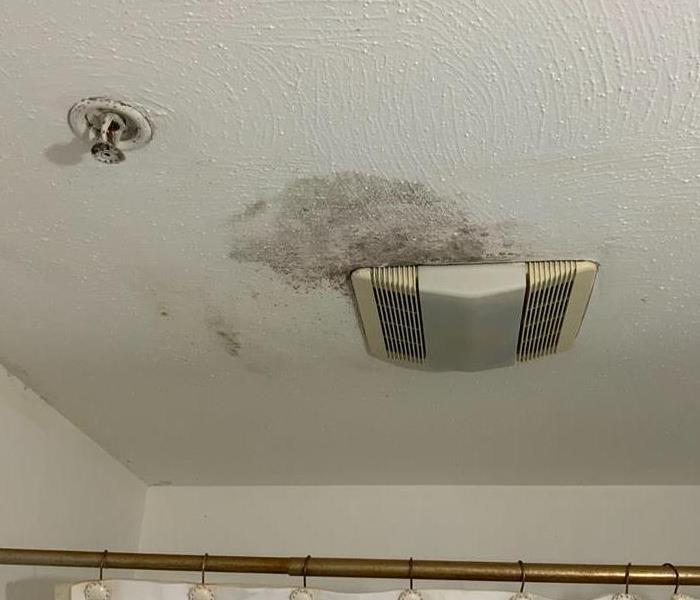What to Expect When Mold Damage Happens in Your Hooksett Home
3/1/2025 (Permalink)
 Humidity fuels mold infestations in Hooksett homes. Call SERVPRO® for remediation.
Humidity fuels mold infestations in Hooksett homes. Call SERVPRO® for remediation.
Standard Mold Remediation to Protect Your Property
You might have discovered mold in several ways. Perhaps you were remodeling your Hooksett home, preparing for an inspection before putting it on the market, or a decidedly musty odor sent you looking for its cause. To minimize mold damage, SERVPRO® provides homeowners with professional mold remediation services.
When we remediate a home in Hooksett, areas with mold damage require restoration and preventative treatments. We perform other tasks to protect your home from future infestations.
Here are a few controllable variables that increase the effectiveness of mold remediation in a home:
- Range of humidity
- Ductwork cleaning
- Airflow
Mold depends on the humidity in its environment. Reducing water vapor in the air helps prevent re-infestation by mold. Microbes thrive when the humidity is 50% or higher. Reducing humidity to below 50% helps minimize microbial activity. However, making your home too dry (30% or lower humidity) can work against you by making the air too dry for your family's comfort.
Ducts carry air from one area of your residence to another and often harbor dust, spores, and other contaminants. Minimizing spores from your home's ventilation system fortifies your property against re-infestation. It makes SERVPRO's mold remediation services last longer.
While microbes and spores use air currents to find new places to colonize, air currents can also help keep anything suspended in the air from settling on surfaces.
During the winter's colder months, reversing the direction in which a ceiling fan's blades rotate can pull warmer air down around the room's perimeter. The bathroom's exhaust fan pulls out more than humidity - it's also helpful in removing spores that bathroom mold might have recently released.
If your Hooksett residence provides a safe harbor for mold and mildew, protect your property from mold damage by calling SERVPRO of Hooksett, Raymond & Epping at (603) 256-9549
Mold Prevention Starts with Prevention: Essential Maintenance Tips for Homeowners
5/20/2024 (Permalink)
 Even with diligent preventative maintenance, it's essential to schedule regular mold inspections by certified professionals.
Even with diligent preventative maintenance, it's essential to schedule regular mold inspections by certified professionals.
Mold, a common household nuisance, thrives in damp, humid environments and can pose significant health risks to occupants while causing structural damage to homes. However, with proactive preventative maintenance measures, homeowners can minimize the risk of mold growth and preserve the integrity of their properties. In this blog, we'll explore essential tips for preventing mold through regular maintenance and upkeep.
1. Maintain Optimal Indoor Humidity:
Mold flourishes in moist environments, making humidity control a crucial aspect of mold prevention. Keep indoor humidity levels between 30% to 60% by using dehumidifiers in damp areas such as basements, bathrooms, and crawl spaces. Proper ventilation, including exhaust fans in bathrooms and kitchen hoods, can also help reduce moisture buildup and prevent mold growth.
2. Repair Water Leaks Promptly:
Even minor water leaks, such as dripping faucets or damaged pipes, can create ideal conditions for mold growth. Inspect plumbing fixtures, appliances, and visible pipes regularly for signs of leaks, and address any issues promptly to prevent water damage and mold proliferation. Don't forget to check under sinks, around toilets, and behind appliances for hidden leaks.
3. Ensure Proper Drainage and Grading:
Improper drainage around the foundation of your home can lead to water infiltration and moisture problems, increasing the risk of mold growth indoors. Keep gutters and downspouts clean and free of debris to facilitate proper water flow away from the foundation. Ensure that the ground around your home slopes away from the building to prevent water from pooling near the foundation.
4. Regularly Inspect and Maintain Roofing:
Roof leaks are a common source of water intrusion that can lead to mold growth in attics and ceilings. Inspect your roof for damaged or missing shingles, deteriorated flashing, and other signs of wear and tear. Repair any issues promptly to prevent water from entering the home and causing damage. Additionally, ensure that attic ventilation is adequate to prevent moisture buildup.
5. Keep Indoor Spaces Clean and Dry:
Regular cleaning and maintenance of indoor spaces can help prevent mold growth by eliminating sources of moisture and organic matter that mold feeds on. Wipe down surfaces prone to moisture accumulation, such as windowsills, bathroom walls, and kitchen countertops. Clean and dry spills or water leaks promptly to prevent mold from taking hold.
6. Monitor Indoor Air Quality:
Poor indoor air quality can contribute to mold growth and exacerbate respiratory issues. Use high-quality air filters in HVAC systems to trap mold spores and other airborne contaminants. Consider using air purifiers with HEPA filters to further improve indoor air quality and reduce the risk of mold-related health problems.
7. Schedule Regular Mold Inspections:
Even with diligent preventative maintenance, it's essential to schedule regular mold inspections by certified professionals. Mold can thrive in hidden areas such as wall cavities, crawl spaces, and attics, making detection challenging for homeowners. Professional mold inspections can identify potential issues early on and provide recommendations for remediation if necessary.
By implementing these preventative maintenance tips and staying vigilant for signs of moisture and mold growth, homeowners can protect their properties and their health from the threat of mold. Remember, prevention is key when it comes to mold, so take proactive steps to keep your home clean, dry, and mold-free.

 24/7 Emergency Service
24/7 Emergency Service

